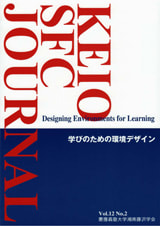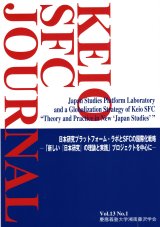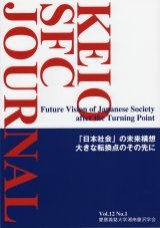- HOME
- KEIO SFC JOURNAL
- Vol.12 No.2

KEIO SFC JOURNAL Vol.12 No.2 Designing Environments for Learning
published on 2013.03
-
What is Embodied Learning? - Significance of Embodiment in Learning and Teaching
Masaki Suwa Professor, Faculty of Environment and Information Studies, Keio University This paper provides a methodology of learning of which the main thrust is embodied learning. The method provided is "embodied meta-cognition" in which one tries to be self-aware of and verbalize what kind of world of things, their attributes and physical relations one interacts with, and thereby generates one's own interpretations of them. That custom in everyday life promotes embodied learning. Parroting someone else's ideas without embodied understanding lacks the attitude of embodiedness. This methodology provides the principles of teaching as well. Teachers do not suffice to describe and tell only the essence of their experiences. Rather, they should provide learners with the descriptions of the world of things, attributes and physical relations that constituted the experiences, so that learners are encouraged to do embodied meta-cognition.
Download this article (PDF): SFCJ12-2-01.pdf -
Multi-vocal Learning Environments that Prepare Everyone for Future Learning
Hajime Shirouzu Senior Researcher, Department for Elementary and Secondary Education Research, NIER Sayaka Tohyama Technical Staff, Division of Technical Service, Shizuoka University This paper proposes that "multi-vocal learning environments" prepare everyone for future learning by two case studies. In the multi-vocal environments everyone has his own voice (=thought) and makes it more distinctive through the exchange of their different voices. The first case indicated that six children interacted with each other constructively and deepened their individual understanding, even though a teacher seemed to lead the class by his one voice. The second case demonstrated that college students learned from their experiences of constructive interaction, in which their thoughts often came to pieces in the face of multi voices but were reconstructed repeatedly. These results imply that learners who learn in multi-vocal environments can adapt to the multi-vocality and utilize it in future.
Download this article (PDF): SFCJ12-2-02.pdf -
Learning through the Use of "Machimicho"
Fumitoshi Kato Professor, Faculty of Environment and Information Studies, Keio University Masaki Suwa Professor, Faculty of Environment and Information Studies, Keio University The present paper attempts to examine the use of "Machimicho" for conducting a workshop on fostering "kansei" to see environments. "Machimicho" is a method to cultivate our sensitivity for observing, recording and sense-making in the context of environmental knowing. To anchor our discussion, we use a case of workshop that we conducted for college students during the summer, 2012. Through the process of designing and practicing the workshop, we rediscovered the importance of communication issues in providing the participants with better learning opportunities. The issues include: the level of abstraction in describing the accounts collected in the field, the importance of developing mentor-mentee relationships, and so on.
-
Field Mining Game as Learning Perspectives
Naohiro Matsumura Associate Professor, Graduate School of Economics, Osaka University In this paper, we propose Field Mining Game (FMG) as a simple way of helping people discover attractive features in nearby fields. Based on FMG practices conducted at Ishibashi and Kimura areas with group discussions and free description questionnaires, we discuss FMG from points of the pros and cons, the rules, the pictures, and the moving trajectories etc. We conclude that FMG works as "learning perspectives" by sharing with others the attractive features of their own perspective.
-
Facilitating Artistic Expression - A Framework and Methodology to Enhance Creative Literacy through Art Workshops
Takeshi Okada Professor, Graduate School of Education, and Interfaculty Initiative in Information Studies, the University of Tokyo Takumitsu Agata Research Fellow of the Japan Society for the Promotion of Science, and Chiba University A creative society needs not only creative experts such as professional artists but also many people with 'creative literacy' who have knowledge and experience of creative activities and the motivation to participate in such activities. Focusing on the interaction between artists' suggestions regarding artistic expressions and their inspirational effects on the expressions of participants in art workshops, this paper proposes a theoretical framework to facilitate the acquisition of creative literacy and introduces an example of such educational practices.
Download this article (PDF): SFCJ12-2-05.pdf -
A University that Designs Societal Systems - Future University Hakodate and Its Environment
Hideyuki Nakashima President, Future University Hakodate Makoto Okamoto Professor, School of Systems Information Science, Future University Hakodate Emiko Tayanagi Project Professor, Center for University-Society Relations and Collaboration (CRC), Future University Hakodate Ken-ichi Kimura Professor, School of Systems Information Science, Future University Hakodate Masaaki Wada Professor, School of Systems Information Science, Future University Hakodate Hitoshi Matsubara Professor, School of Complex and Intelligent Systems, Future University Hakodate Hidekatsu Yanagi Professor, School of Systems Information Science, Future University Hakodate Noyuri Mima Professor, School of Systems Information Science, Future University Hakodate Future University Hakodate (FUN) is jointly founded by several local governments in greater Hakodate area. FUN was established in accordance to the request and desire of local people to have a local intellectual center. To fulfill their expectations, the faculty members conduct various educational and research activities in the local area. The size of the area is not too large nor too small for various intensive activities. In this paper, we clarify the standing point of FUN and enlist major local activities to help understand the relationship between a university and the local society surrounding the university.
Download this article (PDF): SFCJ12-2-06.pdf
-
Influence of University Physical Education Classes on Students' Acquisition of Life Skills - Focusing on Students' Original Skill Level at the Beginning of the Course
Yuko Tokairin Assistant Professor, Faculty of Policy Management, Keio University Tomohisa Nagano Assistant Professor, Faculty of Policy Management, Keio University Takaaki Kato Associate Professor, Faculty of Environment and Information Studies, Keio University Mitsuo Sasaki Professor, Faculty of Environment and Information Studies, Keio University Kohei Shimamoto Assistant Professor, Graduate School of Education, Hyogo University of Teacher Education The purpose of this study is to verify the influence and the difference on the acquisition level of life skills at physical education classes by focusing on students' original skill level at the beginning of the course. The result indicates that there are differences on the point they start and the way they acquire the life skills. The low-level students have the perception that they are not good at physical education classes and communication with others. Therefore, introducing blind walk helped to form organic communication between them and showed that it is effective on the acquisition of life skills.
Download this article (PDF): SFCJ12-2-07.pdf
-
Changes in the Social Evaluation of the Admissions Office Entrance Exam - Analysis of How It Has Been Covered in the Newspaper
Takushi Omuro Master's Program, Graduate School of Social Sciences, Hitotsubashi University The purpose of this research is to examine how the Admissions Office entrance exam¡½introduced by Keio University in 1989 and subsequently expanded throughout Japan¡½has been covered in the newspaper, and to point out the differences in the ways it was covered since its inception. As the result of this research, it has been shown that the Admissions Office entrance exam was covered in the newspaper differently over the years, depending on one of the four periods in which it was treated. Moreover, these differences in coverage illustrate how the public's main interest in education contributes to changes in the way educational policy is conducted.
Download this article (PDF): SFCJ12-2-08.pdf -
Morphological Evaluation of Hippocampal Infolding Development Using Magnetic Resonance Imaging - A Comparison Study between Mental Retardation and Normal Children of School Age
Kayoko Yoshino Senior Visiting Researcher, Keio Research Institute at SFC Ph.D., Researcher, Department of Brain Environmental Research, KATOBRAIN Co., Ltd. Toshinori Kato M.D., Ph.D., Director, Department of Brain Environmental Research, KATOBRAIN Co., Ltd. The hippocampus develops the structure called "hippocampal infolding" that narrows hippocampal fissures in each hemisphere of the human brain in proportion to gestational ages. It has been reported that hippocampal infolding was insufficient or standstill in children with mental retardation. We compared the hippocampal structures between children with mental retardation and normal children in school age using magnetic resonance imaging to investigate the morphologic development of child's hippocampal infolding. In groups of the mental retardation, the hippocampal fissures were expanded bilaterally, and it correlated with the heights of hippocampus. It was suggested that the hippocampus of children with mental retardation was accompanied with the retardation of narrowing of hippocampal fissures which is reflecting hippocampal infolding retardation.
Download this article (PDF): SFCJ12-2-09.pdf
-
A Damage Mitigation Study on the 2011 Thailand Floods based on Satellite Imageries
Kenji Takasaki Senior Visiting Researcher, Keio Research Institute at SFC Shuzo Tanaka Professor, Department of Civil and Environmental Engineering, Faculty of Science and Engineering, Toyo University Sotaro Tanaka Visiting Professor, Environmental System Planning and Space Design, Graduate School of Engineering, Toyo University We surveyed the temporal satellite images of the lower basin of Chao Phraya river, Thailand, that show the 2011 flood conditions. The floods took about two months to subside from the highest water level (late October 2011) to the normal (December 22). A shallow slope of the basin is causing the floods to take a long time to drain. In addition, the banks guarding the urban areas of Bangkok are hindering the drainage in the lower basin of Chao Phraya river. Taking into consideration the regional characteristics, this paper presents three counter measures on how to mitigate the flooding damages. First, pre-discharge of the water from the dam by forecasting the upcoming flood; second, conservation of forest for its water retaining ability, and enhancement of water storage volume by increasing the reservoir capacity and constructing flood control basin; third, augmentation of drainage capacity with the existing and new canals. These measures can lower the high water level of flooding, and it is possible to bring such a damage level of the 2011 floods down to a level of a normal flooding. For actual measures, the Arakawa discharge channel constructed by the Japanese government after the Great Tokyo Floods in 1910 will provide a useful reference.
Download this article (PDF): SFCJ12-2-10.pdf

